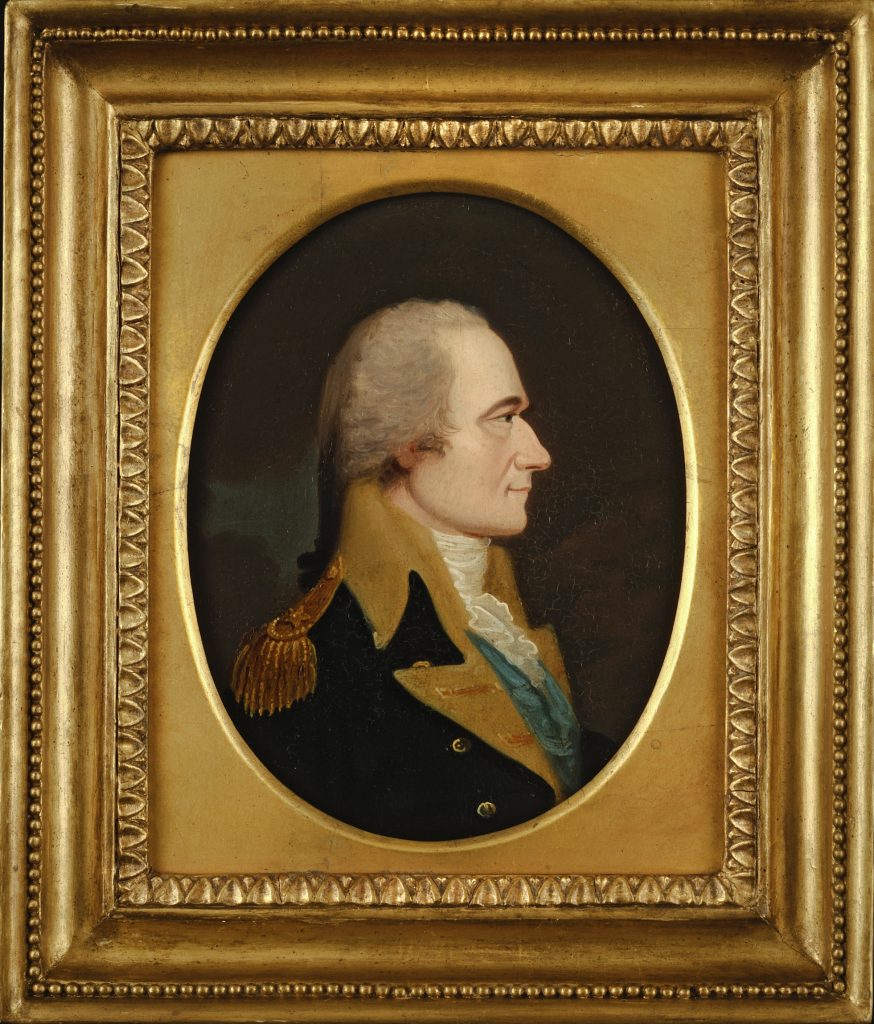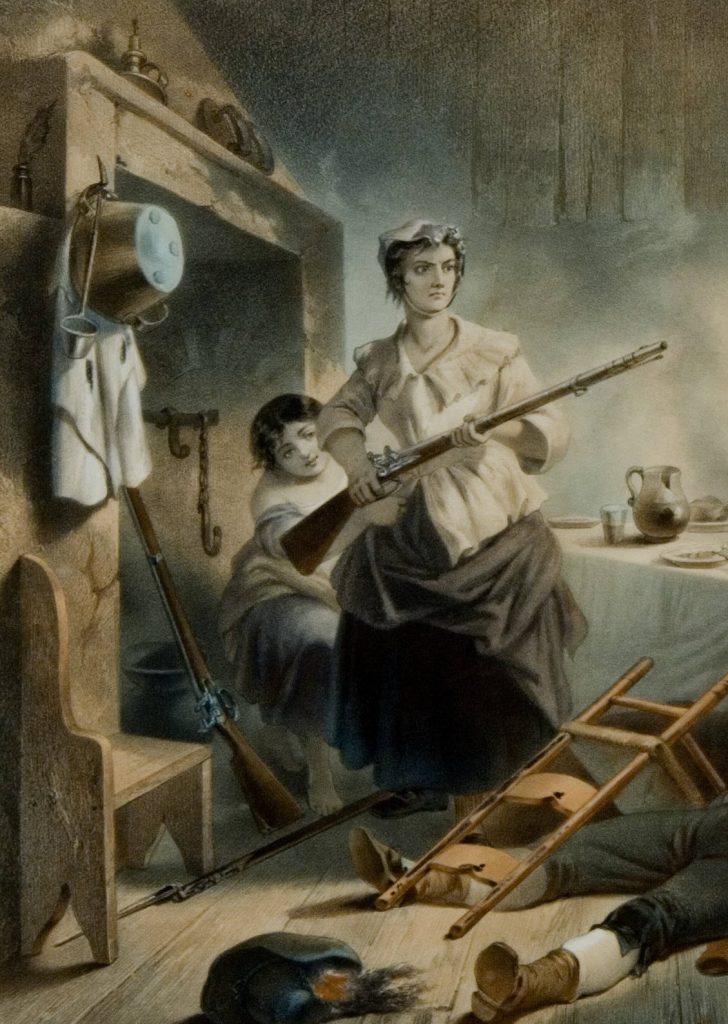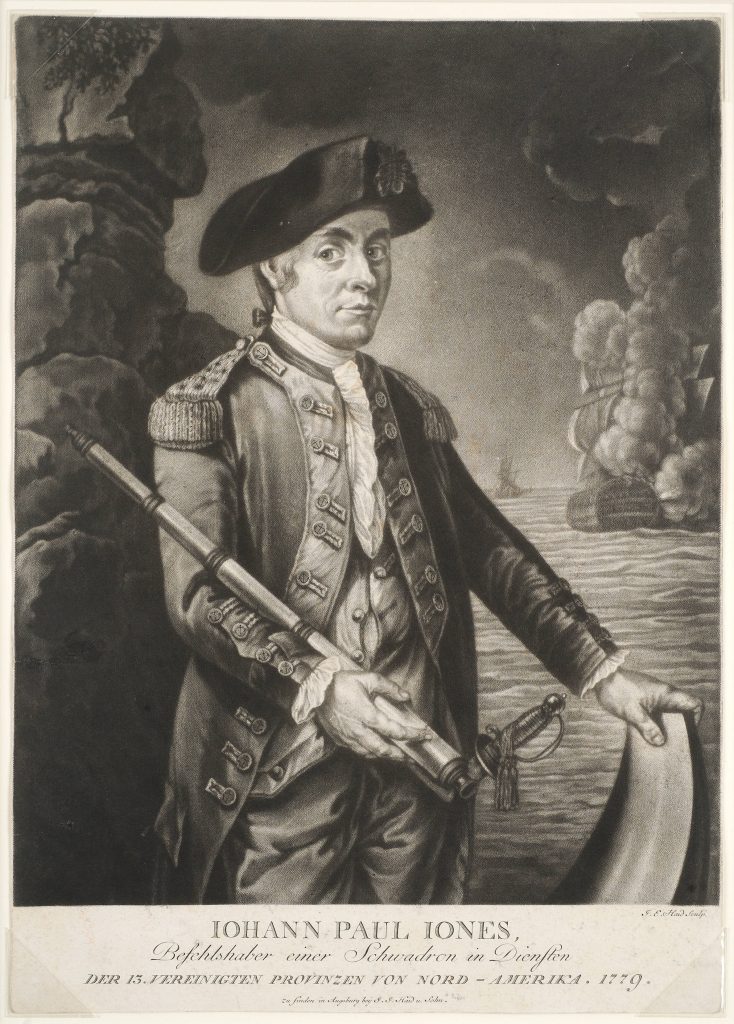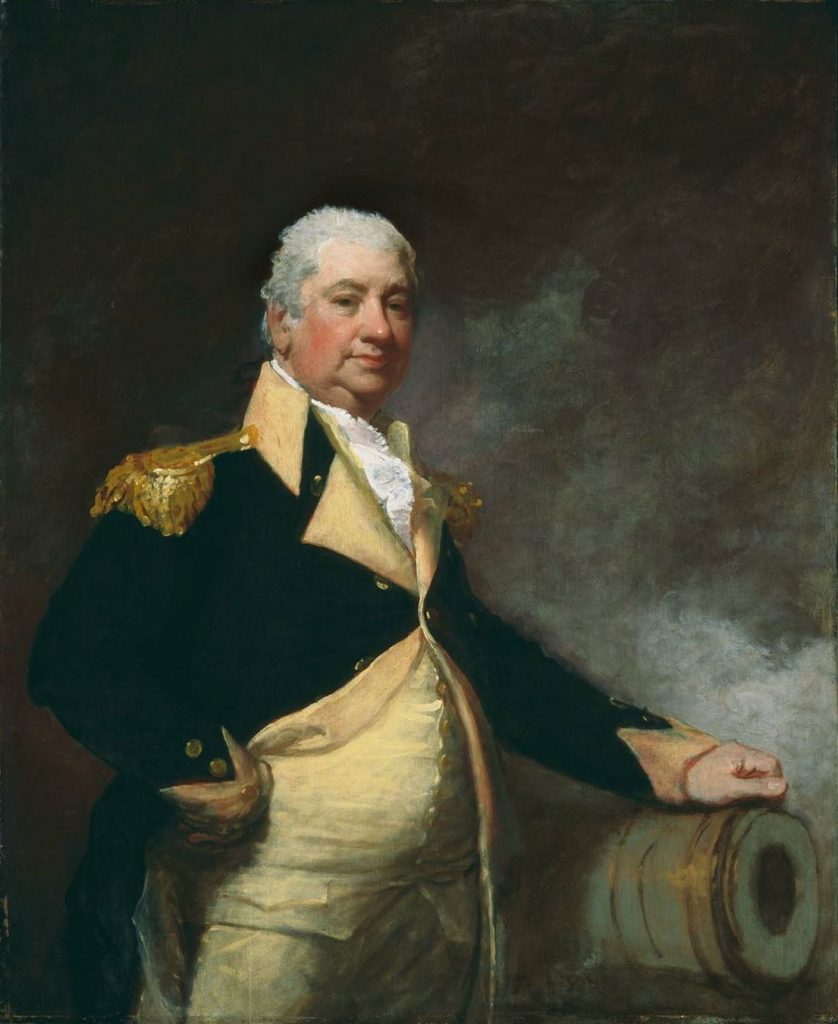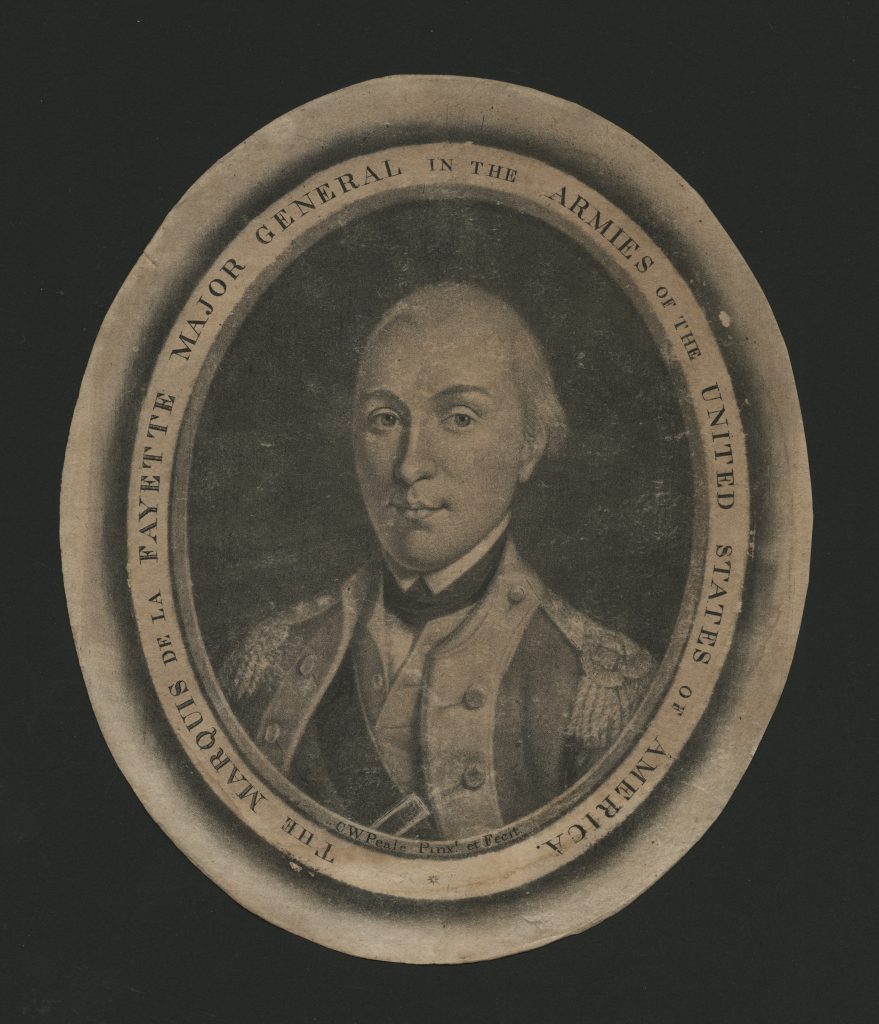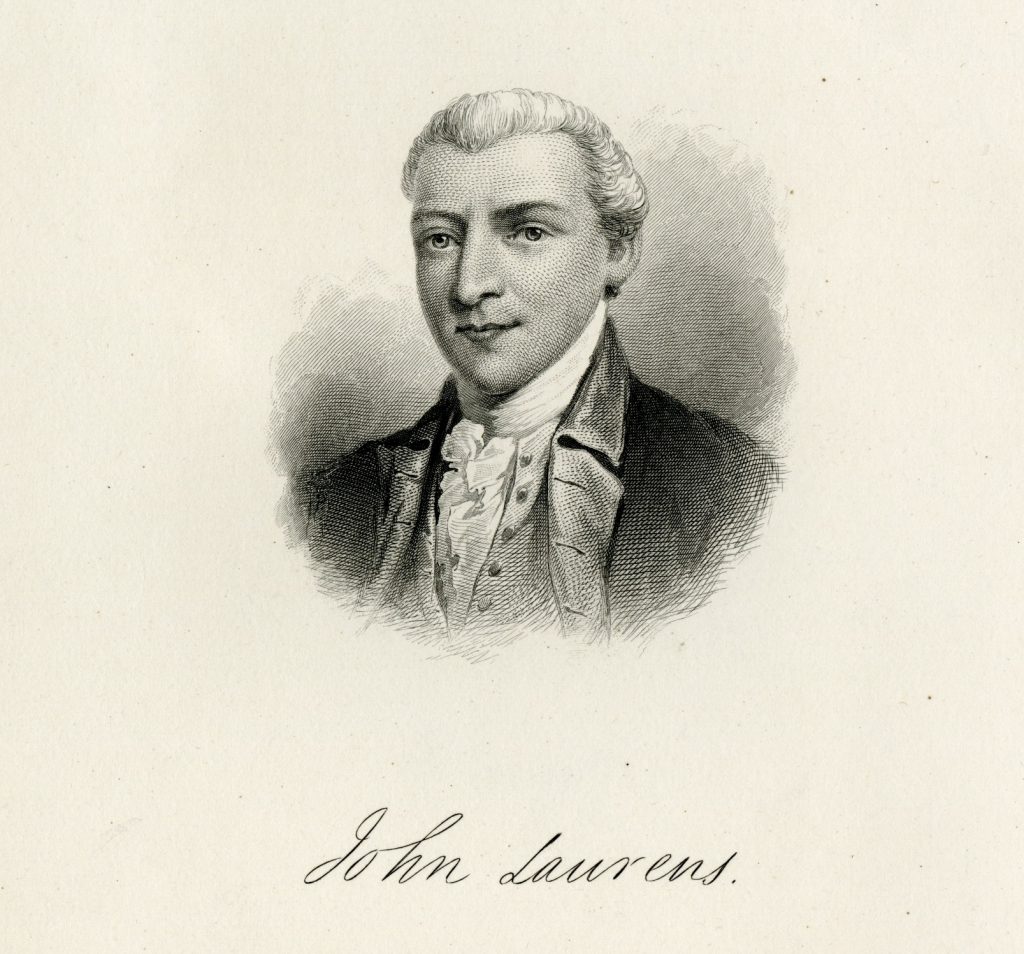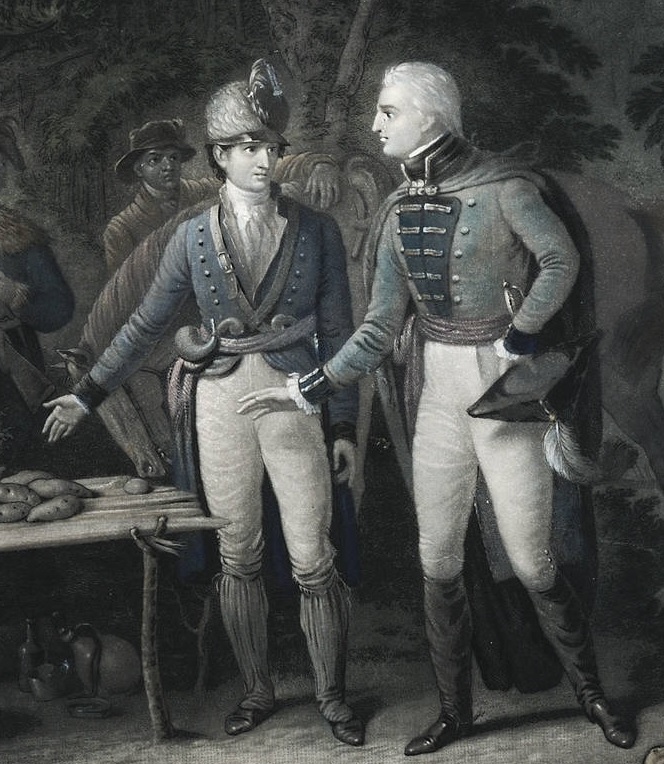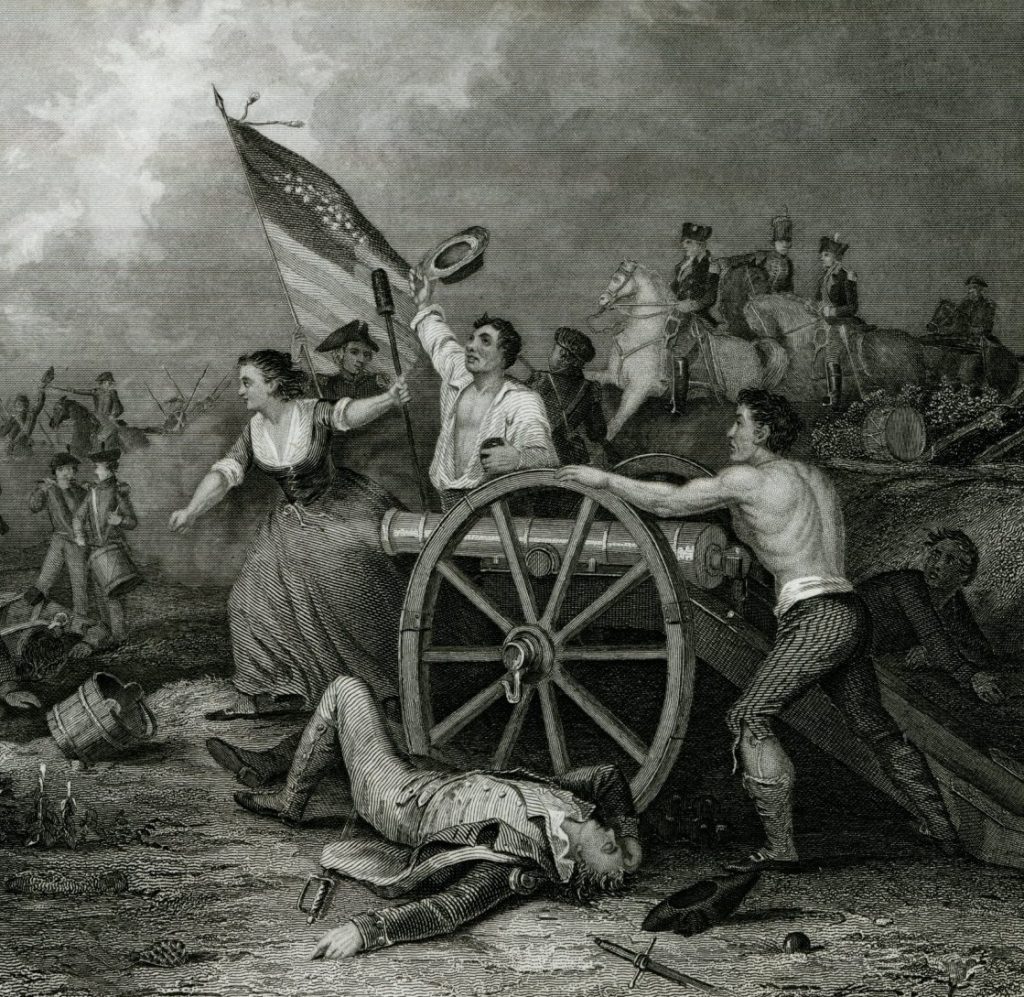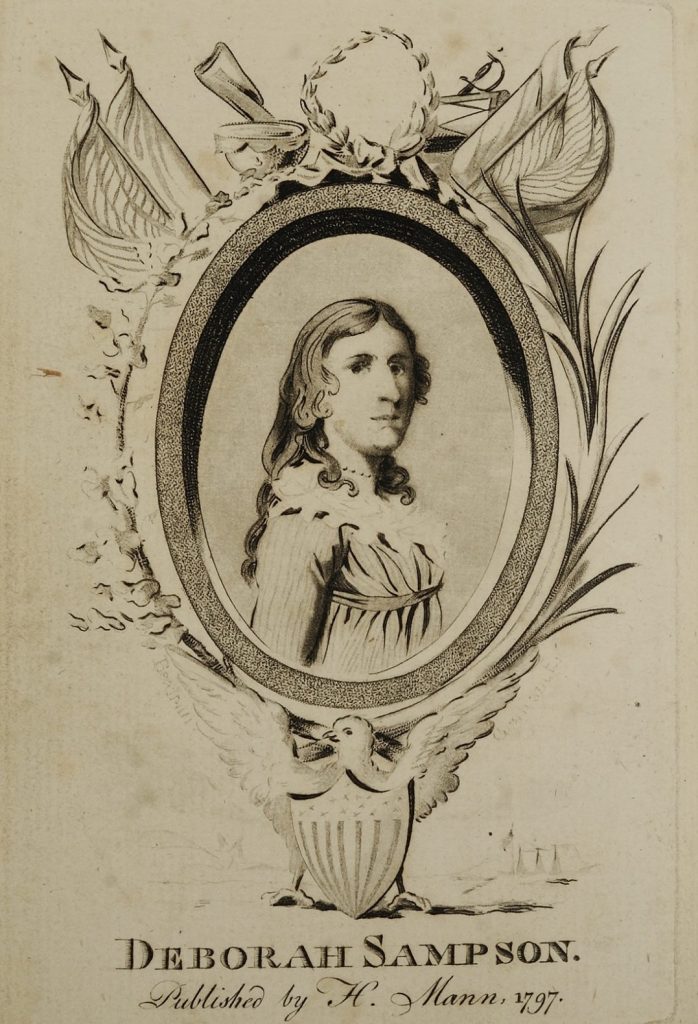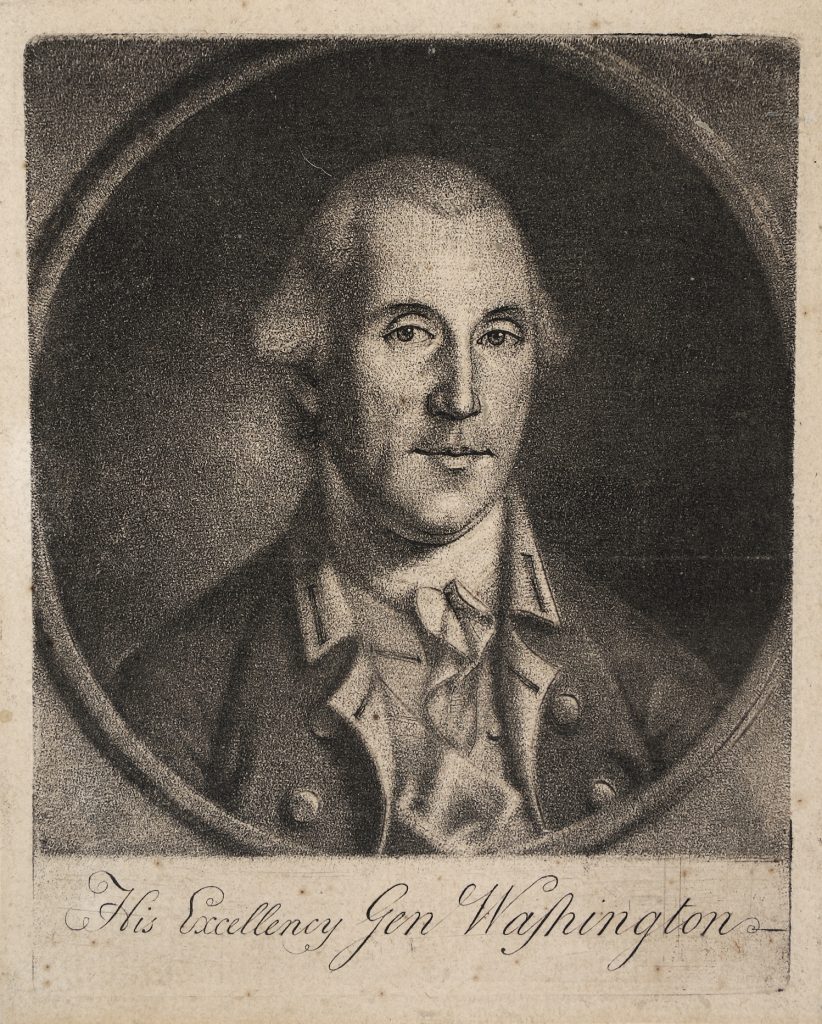Abigail Adams was a constant adviser to her husband, John Adams, both during and after the war. She spoke and wrote against slavery and strongly advocated for women’s rights. She wrote to her husband urging him to consider the rights of women when pursuing national independence.
Ethan Allen was a leader of the Green Mountain Boys of Vermont. Many in Vermont joined the Patriot cause and the region lobbied Congress for recognition as a state. Though unorthodox, Allen considered himself a staunch Patriot.
A bold and aggressive commander, Benedict Arnold quickly established himself as one of the best American generals on the battlefield. Proud and ambitious, he was eager to be recognized and rewarded for his accomplishments. Benedict Arnold was the kind of daring commander General Washington’s Army needed on the battlefield, but he was sensitive about his honor and quick to resent the promotion of others over him.
Kate Barry was a 28-year-old wife and mother in the South Carolina backcountry when a British force under Lieutenant Colonel Banastre Tarleton passed through her neighborhood. Barry rode to rally local militia to join up with Daniel Morgan’s forces to achieve victory at the Battle of Cowpens, South Carolina, one of the most decisive American victories of the war.
David Bushnell sold his share of a family farm to his brother and enrolled in Yale College. He demonstrated that gunpowder could be exploded underwater and built the Turtle, the first submarine. The one-man vessel failed to sink a British ship, but Bushnell continued to work on other weapons.
The Marquis de Chastellux was a French major general during the war. fluent in English, he served as a liaison between generals Rochambeau and Washington, and was third in command of the French troops during the Battle of Yorktown.
A young surveyor, George Rogers Clark was a major in the Virginia militia. After defending frontier settlements, Patrick Henry endorsed Clark’s daring plan to attack forts north of the Ohio River.
Joseph Louis Cook, or Akiatonharónkwen, sided with the Americans during the Saratoga campaign, unlike most Mohawk warriors. As a colonel, he was the highest ranking Indian in the Continental Army.
As a ship captain in 1780, Paul Cuffee rallied against the paying of taxes until black voting rights were granted. His protest led in part to a 1783 law giving all free male citizens the vote in Massachusetts.
Quaker Lydia Darragh eavesdropped on British officers quartered in her home in Philadelphia and heard plans for a surprise attack on General Washington’s army. The next day she left home and warned them.
Jorge Farragut was an experienced Spanish merchant captain who joined the South Carolina navy to fight for the patriot cause. He helped defend Charleston, South Carolina where he was wounded and captured. After being exchanged, he fought bravely at the Battle of Cowpens.
Peter Francisco came to Virginia from the Azores, a group of islands settled by the Portuguese. At 6 feet 8 inches tall with a powerful build, he was known as the “Virginia Giant.” Fighting in many battles of the war, Peter Francisco was famed for his courage and effectiveness in hand-to-hand fighting.
Bernardo de Gálvez was a Spanish general and the governor of the Spanish colony of Louisiana. When Spain entered the war against Britain, Bernardo de Gálvez led Spanish troops to take West Florida from the British.
Horatio Gates was a British Army major until 1769, when he left England and bought a plantation in Virginia. At General Washington’s urging, Congress offered Gates a command. His experience as a British officer made him a talented organizer.
Clément Gosselin was a French Canadian soldier who joined the Americans during the invasion of Canada. He served as an officer in Moses Hazen’s regiment. In 1778, Gosselin returned to Canada to spy on British forces and report to George Washington. He was wounded during the siege of Yorktown.
Nathanael Greene was appointed to command Rhode Island’s troops at the start of the war. Although he lacked military experience, he was a careful student of military history. He became General Washington’s most trusted subordinate and an expert strategist.
Alexander Hamilton was a young New York artillery officer when he came to Washington’s attention after the battles of Trenton and Princeton. He served as Washington’s chief military secretary for much of the war.
Nancy Hart lived with her family in a cabin in western Georgia. She was dedicated to the American cause. While her husband served in the militia, she captured several Loyalist soldiers and served as a Patriot spy.
Lemuel Haynes worked as an indentured servant until 1774 when he joined the militia. He was the first black American ordained as a Christian minister. Inspired by the Revolution’s ideals, he argued that “Liberty is equally as precious to a black man, as it is to a white one.”
The history of Mary Hays is an inspiration for the story of “Molly Pitcher” and was representative of the women who followed their husbands to war and assisted with work in army camps and even on the battlefield. Like many women active with the Army, Mary Hays helped her husband and carried supplies to his cannon crew during battle. Her husband was wounded at Monmouth, where some say she joined the gun crew.
Moses Hazen joined the American Army during its 1775 invasion of Quebec. He commanded Hazen’s Additional Continental Regiment, which distinguished itself in battle.
Virginia governor Patrick Henry was an ardent Patriot. He helped manufacture arms, secure supplies, and enlist recruits. When critics tried to undermine General Washington, Henry came to his defense.
Abigail Hinman was a Patriot and former acquaintance of Benedict Arnold. According to Hinman’s daughter, when the traitor Arnold raided New London, Connecticut on September 6, 1781, Hinman tricked him into sparing the property of several neighbors, then attempted to shoot him from her window, but her musket misfired.
Agrippa Hull was a free African American who served as an aide to Polish engineer Tadeusz Kościuszko. He also tended to wounded and sick soldiers, working alongside army surgeons later in the war.
The Scottish-born John Paul Jones commanded several American ships during the war. He was a hero to many Patriots, but the British considered him little more than a pirate.
Johann de Kalb was an officer in the French Army. In 1768, the French government sent de Kalb on a secret mission to America to learn whether the disagreements between the colonists and Britain might lead to war. He later returned to volunteer in the Continental Army. Mortally wounded in the Battle of Camden, South Carolina, he remarked before his death, “I die the death I always prayed for: the death of a soldier fighting for the rights of man.”
A young Boston bookseller, Henry Knox became George Washington’s chief of artillery and soon earned a reputation as one of the most dependable officers in the Continental Army. He made the Continental artillery a powerful fighting force. In late 1775 he led an expedition that brought 59 artillery pieces from Fort Ticonderoga in New York to General Washington’s army outside Boston.
Tadeusz Kościuszko was a Polish military engineer who helped build fortifications at Saratoga, New York, aiding the American victory. Later he oversaw the building of West Point and helped lead Patriot troops. His later support for abolition led to his desire to leave much of his money to purchase freedom for enslaved persons in the United States.
Working closely with the marquis de Lafayette, James Armistead, an enslaved African American man, spied on British forces in Virginia. After the war, he secured his freedom and purchased his own farm where he raised his family. He added “Lafayette” to his name in honor of the general he served with during the war.
A wealthy and idealistic French aristocrat, the Marquis de Lafayette came to America to fight for liberty. When he arrived, Congress made him a major general though he was only nineteen years old.
John Laurens was an aide to General Washington during the war. A skilled public speaker, Laurens raised funds from the French court and lobbied against the practice of slavery in America. He supported the enlistment of enslaved persons in the Continental Army in exchange for their freedom.
A British officer before the war, Charles Lee settled in America in 1773 and resigned his commission in 1775 to join the Continental Army. He was never without his dogs, dressed sloppily, and always expressed his opinions freely, even when he disagreed with General Washington.
Henry Lee III was a member of one of the most prominent families in Virginia. He joined the Continental Army as a captain of dragoons—a kind of cavalry that fought on horseback. Known as “Light Horse-Harry,” he commanded a corps of cavalry and infantry called Lee’s Legion. He became famous after his Legion fought heavily in the Carolinas and Georgia.
Benjamin Lincoln, a Patriot leader in Hingham, Massachusetts before the war, he went with his militia to support General Washington’s army around New York in 1776. He impressed Washington, who recommended him for a Continental Army commission.
Sybil Ludington was sixteen years old when the British mounted a raid on supplies at Danbury, Connecticut. Though young, she was determined to help the American cause. While her father, a militia colonel, prepared to march against the British, Sybil rode 40 miles through the night to rouse Patriots to arms.
Francis Marion served at the defense of Fort Sullivan in 1776. After the fall of Charleston in 1780, he helped lead the Patriot resistance in the backcountry. Known as the “Swamp Fox,” Marion was a master of guerrilla warfare.
A leader of the Sons of Liberty in New York City, McDougall was chosen to command the First New York Regiment. Quickly promoted to general, he became a skilled officer, always looking out for his men.
Allan McLane was an officer serving under General Washington who led troops on critical foraging parties instrumental during the supply crisis at Valley Forge.
A successful merchant when the war started, Thomas Mifflin hoped for battlefield glory, but accepted the often criticized, and at times nearly impossible job of managing the Army’s supply operations.
A veteran of the French and Indian War, Daniel Morgan raised a company of riflemen on the Virginia frontier to join the Army outside Boston in 1775. The New Englanders were amazed at the skill of Morgan’s sharpshooters. In the south, he led Patriot forces to victory at the Battle of Cowpens on January 17, 1781.
Robert Morris was one of the most successful merchants in Philadelphia. In service to the cause, he managed shipments of arms and ammunition from France, and supplies the Continental Army with enormous amounts of his own money during critical periods of the war.
William Moultrie was at Fort Sullivan in South Carolina when the British attacked in 1776. Some doubted that the fort, quickly built out of palmetto logs and sand, could stand up to a British attack. Moultrie worked tirelessly to supply the fort with cannons and ammunition. In 1780, Moultrie was captured when Charleston fell to the British.
Peter Muhlenberg was a Lutheran minister, a politician, and a colonel in the Continental Army. He commanded the 8th Virginia Regiment and became an influential leader in the Continental Army. After the war he settled in Pennsylvania and was elected to Congress.
Known as the Stockbridge Indians, the Munsee, Mohican, and Wappinger tribesmen were led by Daniel Nimham,a sachem, or wise man, of the Indians from the lower Hudson River Valley, Connecticut, and western Massachusetts. Many of these Indians enlisted to serve the Patriot cause. These warriors were ambushed and killed by Loyalist troops in 1778.
Thomas Paine failed in business in Britain but had a gift for inspiring people with his writing. He wrote pamphlets making the case for independence, arguing for liberty and independence from monarchy. He wrote in a way many people understood, inspiring thousands to enlist and support the cause.
Salem Poor was a formerly enslaved man who purchased his freedom and enlisted in the Continental Army. He was cited for heroism at Bunker Hill, and is credited with mortally wounding British officer James Abercrombie.
Israel Putnam was a veteran of the French and Indian War before the Revolutionary War. He was a notable figure at the Battle of Bunker Hill and was later put in command of the Eastern Division.
Esther De Berdt Reed was the wife of prominent Pennsylvania politician Joseph Reed. She wrote “The Sentiments of an American Woman” to express her patriotism and her view that women should organize to support the cause. To support the Continental Army, she created the Ladies Association of Philadelphia, which raised money for shirts and clothing. Sadly, she died before the drive was completed.
Famed for his “Midnight Ride” to rally Patriot militia, Paul Revere was a skilled artisan. After studying the colonies’ only functioning gunpowder mill, Revere set up a New England mill to supply the Continental Army.
David Rittenhouse was a clockmaker and a self-taught intellectual committed to the Patriot cause. He was treasurer of Pennsylvania during the war and later became director of the United States Mint.
King Louis XVI chose the Comte de Rochambeau to command the French land forces sent to America because he was dependable and diplomatic. Rochambeau arrived with an army of 5,500 men with orders to accept George Washington as his commander-in-chief.
Tradition credits seamstress Betsy Ross with sewing the first American flag. While there is little evidence of this, she was nonetheless an ardent Patriot who assisted in making uniforms, tents, knapsacks and other goods for the Continental Army.
Benjamin Rush served in the Continental Congress and was surgeon general in the Continental Army. His work keeping the men healthy bolstered the Army’s strength.
Haym Salomon was born in Poland and settled in New York in 1775. When war broke out he joined the Sons of Liberty. The British arrested him as a spy, released him, and then arrested him again and sentenced him to death. He escaped and made his way to Philadelphia. As a Jewish community leader, Salomon championed religious freedom.
Deborah Sampson was a soldier who disguised herself as a man. she enlisted under the name “Robert Shurtleff” and joined the light infantry company of the 4th Massachusetts Regiment. When discovered, she was granted an honorable discharge. After the war she gave lectures on her service.
Maryland planter William Smallwood was a French and Indian War veteran when he was appointed to command the 1st Maryland Regiment, a unit that distinguished itself during the New York campaign.
Arthur St. Clair, who had previously served in the British Army, was commissioned a colonel in the 3rd Pennsylvania Regiment by the Continental Congress. He rose quickly through the ranks.
Baron von Steuben was a veteran army officer from Prussia (today part of Germany). He served as inspector general of the Continental Army and directed the training of the Army during the winter at Valley Forge, greatly improving the Army’s fighting ability.
Wealthy William Alexander of New Jersey claimed to be a titled Scottish lord, and is referred to as “Lord Stirling.” Promoted to major general, he was one of General Washington’s favorite commanders—a loyal and brave officer known as a stubborn fighter. As a brigadier general, Lord Stirling fought bravely at Brooklyn in 1776 and was captured. Released in a prisoner exchange, he returned to General Washington’s Army, and was promoted to major general.
John Sullivan led an expedition into territory controlled by the British-allied Iroquois. Raiding villages, his actions led to famine and disease among the Iroquois. He later served in Congress.
Tewahangarahken was an influential leader of the Oneida people, one of the only Iroquois tribes to ally with the Patriots against the British. He was married to Tyonajanegen. The two of them distinguished themselves during the Saratoga campaign where they fought bravely for the American cause.
Francis Vigo was born in Italy and served in the Spanish Army. At the beginning of the Revolution he was a fur trader in the Spanish colony of Louisiana.When the British captured the fort at Vincennes (in present day Indiana) Vigo provided intelligence to George Rogers Clark, assisting him in the recapture of the fort for the American cause.
A talented physician, Joseph Warren nonetheless demonstrated impressive leadership skills. Brilliant, calm and always in command of himself, he seemed like an ideal commander. The Massachusetts government made him a major general.
A skilled writer, Mercy Otis Warren was one of the most important intellectuals of the Revolution. Otis argued political rights were as important to women as to men. She was the sister of Massachusetts Patriot leader James Otis and wife of Patriot leader James Warren.
Already a veteran leader, George Washington was appointed general and commander-in-chief of the Continental Army. He served in that position until victory was achieved in 1783.
Martha Washington was the wife of George Washington. She regularly traveled to stay with him at his winter encampments and became a beloved matriarchal figure.
A successful surveyor who also worked as a tanner, Anthony Wayne raised a Pennsylvania militia company in 1775 and was appointed colonel of the 4th Pennsylvania Regiment early the next year. Anthony Wayne fought bravely at the Battle of Monmouth, New Jersey earning praise from General Washington himself. Wayne was given commands of increased importance as the war continued.
The first published African American female poet, Phillis Wheatley wrote extensively during the Revolution, with her poetry reflecting and supporting its highest ideals.
